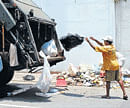Basking in the glory of its “IT Capital” tag brandished globally, Bangalore has just had an inglorious wake-up call.
The city’s notoriously ineffective, unscientific waste management has been laid bare by
“The New York Times” in a strikingly incisive report titled “India’s plague, trash, drowns its Garden City during strike.”
Stung by this global attention of the stinker kind, the civic agencies are frantically, cluelessly looking for a way out for the mounting garbage piles.
The Mayor, D Venkatesh Murthy, chose to compare Bangalore with New York. The issue of waste disposal is ubiquitous, affecting every city, he quipped, but was quick to assert the BBMP’s resolve to rid the City of the garbage crisis through citizens' participation. He meant the faltering segregation-at-source initiative.
Palike Commissioner Rajneesh Goel, widely quoted in the NYT report, tried to downplay the report as routine. “It is true that for the last eight years we have been running the landfill at Mandur in an unscientific way, which they have highlighted. I also spoke about some of our initiatives to dispose of waste in a scientific way, including segregation of waste at source, but they did not focus much on our measures,” said Goel.
The global publicising of Bangalore’s garbage menace had Chief Minister Jagadish Shettar reacting, too. On Monday, he claimed the government was doing everything in its capacity to tackle the menace. But he was clear the report wouldn’t tarnish Bangalore’s image.
“Whatever happens in Bangalore becomes international news. That does not mean that this problem has brought disrepute to the City,” he noted. He critiqued the report for not stressing on the government’s remedial measures.
Published on October 26, the comprehensive NYT report had this telling line: “Bangalore, the capital of India’s modern economy and home to many of its high-tech workers, is drowning in its own waste.” For proof, its correspondent had wandered deep into Mandur, the epicentre of the villagers’ protest against the landfill, and traced the stink right from the unscientific collection, management and disposal of the garbage piles.
“Some neighbourhoods have not had trash pickups for nearly three weeks, and vast mounds of garbage are scattered through what is known in India as the Garden City,” the report read, a line too familiar to Bangaloreans.
To drive home the point, the report had Amiya Kumar Sahu, president of the National Solid Waste Association of India, asserting: “Bangalore used to be India’s cleanest city but now, it is the filthiest.”
For “The New York Times”, the transformation was the dark side of the country’s rapid economic growth.
“Greater wealth has spawned more garbage, and the managers of the country’s pell-mell development have been unable to handle the load.”
Disgrace to City
For Kiran Mazumdar Shaw, Chairman and the Managing Director of Biocon Limited, the bad press was a “disgrace for the City.”
“The Bruhat Bangalore Mahanagara Palike is taking corrective measures but one thing we must realise is that what has been going wrong for almost a decade cannot be corrected within weeks,” said Shaw.
Her suggestion: Let the BBMP work with private organisations such as City Connect to scientifically dispose of waste.
Last heard, “The New York Times” report had the Palike propose intensive training sessions on waste management for its officers and the Pourakarmikas, a Rs 11 lakh initiative beginning December 1.
